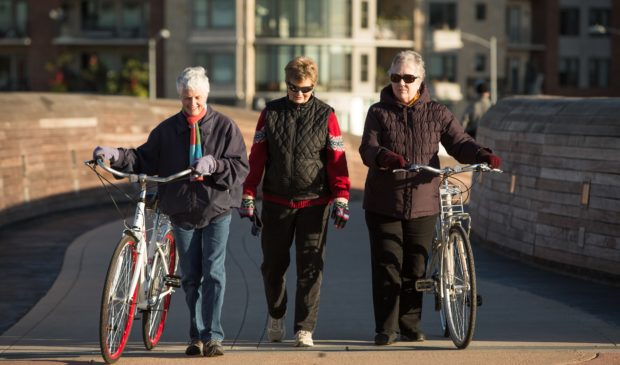Council approves Healthy Streets program to ease crowding on sidewalks, trails
Friday, May 8, 2020 by
Ryan Thornton The coronavirus pandemic has alleviated Austin’s chronic traffic congestion and brought another issue into the foreground: the immediate need for space to walk, bicycle, use a wheelchair or push a stroller at a safe distance from others and from car traffic.
In response, City Council advanced a resolution from Council Member Paige Ellis on Thursday to start converting neighborhood streets into “Healthy Streets,” with the first set of conversions to be ready by May 21. The program will use temporary infrastructure like A-frame signs and cones to open up space for cycling and walking while still allowing drivers to access their residential streets.
“In neighborhoods that are lucky enough to have sidewalks, people are crowding onto 5-foot pathways next to 40-foot roads,” said Council Member Natasha Harper-Madison. “This effort isn’t just about the benefit of joggers and cyclists – it’s about people in wheelchairs who need to safely get to the pharmacy; it’s about grocery store clerks and health workers who need to get to their bus stops.”
People are currently walking and bicycling more and driving half as much as usual; yet rates of serious traffic injury are up 20 percent since the city issued its Stay Home-Work Safe order in late March. Of course, traffic fatalities are also still up this year, with 33 deaths since Jan. 1 compared to 25 deaths at the same time last year. City officials have speculated that absence of congestion means some motorists are driving faster than normal. At the same time, a lack of active transportation infrastructure and the need for social distancing is leading those on foot, bike or wheelchair into car traffic lanes.
A local transportation advocacy coalition led by Walk Austin has been building support for a “slow streets” initiative for weeks. Since creating an online petition on April 28, the effort has collected over 1,080 signatures of support.
“This is a historic decision,” said Adam Greenfield, board president of Walk Austin, following the vote. “With this simple but powerful direction, Council has acknowledged that our neighborhood streets are public spaces for everyone and crucial tools in meeting the Covid-19 challenge. Streets must be used during this unprecedented period for more than just one function – driving – and instead must be opened up to include more people and more activities.”
Ellis also thanked the individual work of George Cofer, founder and CEO of Hill Country Conservancy; Ted Siff, board member of Austin Outside; and the Austin Transportation Department for helping the community stay safe from Covid-19.
In addition to meeting the demand for social distancing and active transportation during the pandemic, Siff said the program will be a “great step” toward meeting the mode-share goals of the Austin Strategic Mobility Plan, which aims to lower the percentage of solo driving trips from 74 percent to 50 percent over the next 20 years.
Focusing exclusively on non-arterial streets without public transit service, the program will create a goal of “Healthy Streets” miles prior to each phase. Following the initial phase in the next two weeks, city staffers will be consulting Council members as well as community organizations and residents to select streets for conversion in subsequent phases. To cut costs, volunteers may be charged with marking off and monitoring the streets.
Slow streets plans are rapidly rolling out in cities across the nation, with many programs already in place for weeks. The resolution directs Austin to research successes and failures in cities such as Oakland, San Francisco, Denver, Kansas City, New York City, Seattle, and Portland, Oregon.
While the resolution initially called for a “wind-down” once the pandemic has substantially faded, Council Member Kathie Tovo posted an amendment to the City Council Message Board Wednesday asking for “recommendations for instituting long-term investments in ‘slow streets’ programs citywide when social distancing is no longer necessary.”
“We have heard a great deal of support from our community about safe streets efforts, and cities such as Milan and Paris are committing to long-term investments in bicycle and pedestrian infrastructure post-pandemic to continue to reduce carbon emissions and traffic congestion,” Tovo said.
“Rather than wind down this initiative as contemplated in the resolution, I believe that it is worthwhile to retain appropriate components of permanence as informed by the learnings in the pilot.”
Harper-Madison expressed a similar sentiment about the opportunity for systemic change: “We have other cities around the country and beyond that are just so much more advanced. London and Paris are using this pandemic as an opportunity to make massive investments in bike and pedestrian infrastructure, and I hope that this is an opportunity for us to be thinking big-picture and sustainable future-facing infrastructure investment and change.”
Ellis posted to her Twitter account Thursday with gratitude for the support from Council and asking residents to show their support online using the hashtag #HealthyStreetsATX.
Photo made available through a Creative Commons license.
The Austin Monitor’s work is made possible by donations from the community. Though our reporting covers donors from time to time, we are careful to keep business and editorial efforts separate while maintaining transparency. A complete list of donors is available here, and our code of ethics is explained here.
You're a community leader
And we’re honored you look to us for serious, in-depth news. You know a strong community needs local and dedicated watchdog reporting. We’re here for you and that won’t change. Now will you take the powerful next step and support our nonprofit news organization?









